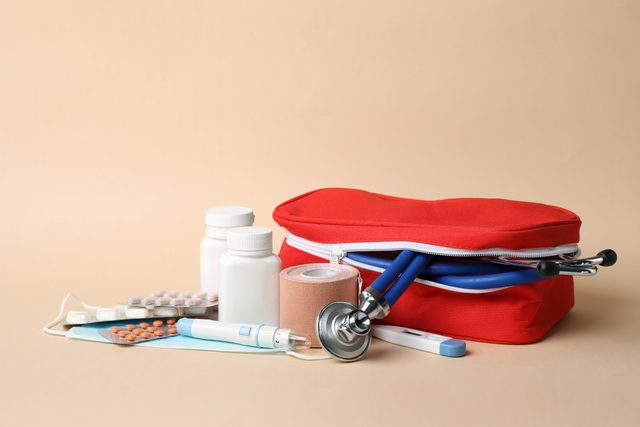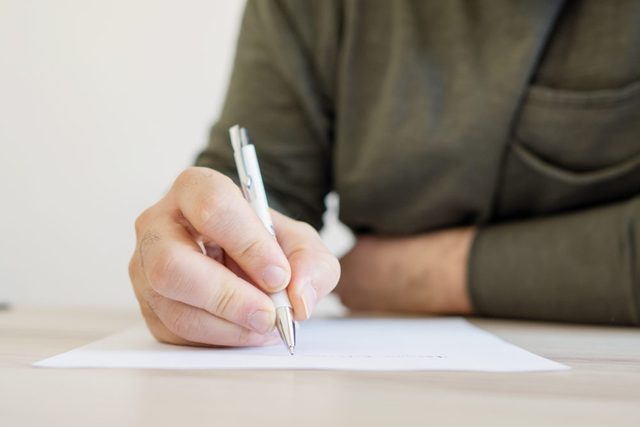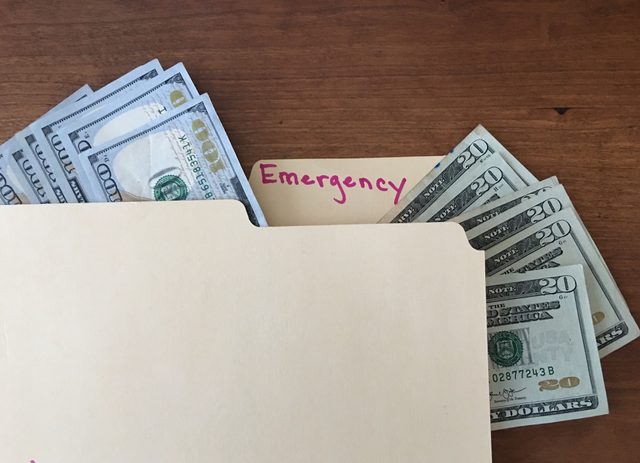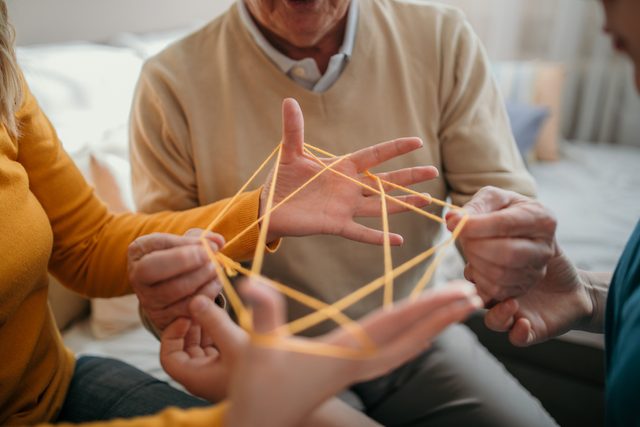
What to pack in a home emergency kit
If time has taught us anything, it’s hope for the best but prepare for the worst. The list of possible worst case scenarios now includes Covid-19 and other infectious diseases in addition to the floods, hurricanes, and wildfires that may already be on your radar, depending on where you live.
“We’re looking at seasonal weather-related disasters going on at the same time as Covid-19,” says Jeff Schlegelmilch, deputy director of the National Center for Disaster Preparedness (NCDP) at Columbia University in New York City. (The Atlantic hurricane season runs from June 1 until the end of November).
In 2018, 62,339 weather events, including hurricanes, heat waves, and winter weather, caused 782 deaths and 1,797 injuries, according to the National Safety Council.
“Crises are terrifying, and the only way to make them less terrifying is to be prepared,” says NSC spokesperson Maureen Vogel. “One of the first things is keeping a home emergency kit always on hand.” (You should also try this disaster planning app, even if you’re not a prepper.)
Keep the kit in a closet or somewhere near an exit door and have another one in your car, Vogel advises.
Here’s what experts recommend packing if you need to stay at home or if you need to leave in a hurry:

A communication plan
Sometimes we know that a disaster is on its way but often there’s no warning at all. Make sure you have a communication plan in place for either scenario and one that takes into account the different times disasters can occur. You and your family could be at school or work or sleeping when disaster strikes.
“What is your plan to meet up, to reconnect with folks?” asks Schlegelmilch. Have a list of phone numbers in the kit. You should also include an actual place (perhaps a relative’s place) where people can gather should cell phones become unavailable.
Finally, make sure everyone in your family, including and especially any kids, are familiar with the plan, advises Anthony Tornetta, a spokesperson for the American Red Cross.

H2O
You need to store some water, but how much? It depends on the disaster as well as where you are geographically and your health status.
“Covid-19 is not going to impact your ability to walk to the sink and turn on the faucet,” says Tornetta. A hurricane, on the other hand, very well might.
The general rule of thumb is one gallon of water per person (and per pet) per day, aiming for a total three days’ supply, according to the Centers for Disease Control and Prevention (CDC). That said, children, mothers who are nursing, people who are sick, and people in warmer climates may need more, according to the Department of Homeland Security’s ready.gov. The NCDP has a Preparedness Wizard that will help you calculate how much water, and other items, you may need. (Here are the signs and symptoms of dehydration.)

Non-perishable food
As with water, experts recommend that you have enough non-perishable food on hand for people and pets to last at least three days, quite possibly more, says Schlegelmilch, who is co-author of the forthcoming book Rethinking Readiness.
Focus on nonperishable items like dry goods and canned goods but some frozen products are also OK. “Even if you lose power, you’ve got a few days before they start to spoil,” says Schlegelmilch. “A combination of frozen and nonperishable is fine.”
As for what kind of food, Vogel recommends items that are protein-packed and can be prepared without electricity, such as tuna, peanut butter, or granola bars. If you or anyone in your family has special dietary needs, make sure you take those into account.
And oh yes, don’t forget to have a non-electric can opener or choose cans that have pop-tops, says Tornetta.

First aid kit
It’s important not only to have a well-stocked first aid kit, but the knowledge to effectively use each item in that kit as well, says Melanie Hart, senior underwriter for the United Services Automobile Association (USAA). “The American Red Cross has some great tips—if you aren’t sure, get one of their ready-made first aid kits,” she adds. The organization also has a series of apps that can help you build an emergency kit and more. (Here are first aid tricks from ER doctors.)
Also make sure to include contact lens solution, if you wear contact lenses, and asthma inhalers, according to a disaster supplies checklist from the Department of Homeland Security. Also include personal hygiene products and over-the-counter and prescription medications (a seven-day supply, says Tornetta). These days, it would be a good idea to include hand sanitizer, gloves, and face masks, as well. (Here’s how to make your own face mask.)
The American College of Emergency Physicians recommends keeping the kit in a clear, waterproof, plastic container and putting it in a visible place.

Multipurpose tool
Simple or complex, multipurpose tools can be lifesavers. “Your multipurpose tool should be able to do what other widely used tools—like a screwdriver, pair of pliers, or scissors—can do,” says Hart. And definitely a can opener, if you haven’t invested in pop-top cans. (You might also want to invest in these health gadgets that could save your life.)
Your car should also have its own emergency tool kit which includes water and high-energy non-perishable food but also an inflated spare tire, the jack and wheel wrench, jumper cables, reflective triangles and brightly colored cloth, says Vogel. If the weather’s cold, add a snow brush, shovel, blankets, and windshield washer fluid.

Cash
Covid-19 isn’t likely to affect ATMs or credit-card machines, but hurricanes and other natural disasters could put them out of commission.
“The digital systems work pretty well but after Katrina there were prolonged power outages,” says Schlegelmilch. “You may be in a situation where credit-card machines [and ATMs] are down.”
That means you may have to rely on good old hard cash during an emergency.
“Not everybody has enough money to do this but if you’re able to set aside a few dollars, it’s definitely a good thing,” Schlegelmilch adds.
Ready.gov recommends having small bills available so you can buy fuel and food.

Gas
“Fill up early and fill up often,” Hart says. “With Hurricane Irma, we had advance notice—it’s important to think, ‘What do I need to do to start preparing right now?’ Even if you don’t know where the hurricane’s going, as soon as it’s a possibility for you in your area, think about things like gas. Your presence of mind when a catastrophe is far away is much clearer than your presence of mind when you’re in the throes of that catastrophe.”
Schlegelmilch recommends having your tank at least half full at all times.
And while having extra gas cans may be tempting, bear in mind that this can be a fire hazard,

A change of clothes
Or two or three. It’s important to have the right kind and amount of clothes you’ll need in any given situation.
“Consider protective clothes and outerwear. Think: coats, windbreakers, ponchos, rain jackets,” Hart says. She also notes the importance of items that will wear well across all climates—so anything versatile, durable, and comfortable—is a universally safe choice. “Follow the same three-day rule here, too,” she says. “And, as we talked about earlier, remember to change your supply out annually. Our children grow from year to year.”
Layers are an especially good idea for any warmer or colder conditions, says Tornetta. As are socks in case you get wet, Schlegelmilch adds.

Closed-toe shoes
If you’re leaving really quickly, you may not have a chance to pick your ideal shoes but, if you can, take closed-toe shoes. “You might not know exactly where you’re going,” says Schlegelmilch. “If you have to be in a shelter environment or walking through areas, that’s just to protect your feet from all of that. If you can only grab one pair of shoes, don’t grab the flip flops.”
This could be especially important in areas that have been damaged by hurricanes or tornadoes. “There’s a lot of debris,” says Tornetta. “We want our team to wear closed-toe shoes so there’s no chance of getting a splinter or some kind of infection.”

Low-tech basics
Technology isn’t always reliable, especially in a disaster. That means you should have some low-tech options on hand such as a hand crank, battery-powered radio and flashlight, and extra batteries, says Vogel. Garbage bags are good not only for holding trash but also to keep things dry, and matches in a waterproof container are a good idea too.
Light plastic sheeting and duct tape can be invaluable if you have broken windows because of a hurricane or tornado, Vogel says.
Just in case technology does survive the storm, fire, or pandemic, keep some extra portable charging blocks on hand as well, says Tornetta. And you should also have a car charger for your cell phone.

Important documents
This is important not just during the disaster, but for rebuilding your life after. Having key legal and personal documents can go a long way towards minimizing stress once the immediate damage has passed, says Hart. Make sure you know the signs that you may be suffering from serious stress.
Iowa Legal Aid recommends keeping these papers together so you can grab them in a hurry:
* Identification, be it a driver’s license, passport, or another photo ID.
* Insurance documents like life insurance, flood and fire insurance as well as homeowners or rental insurance.
* Legal documents. This includes birth certificates, any child custody or adoption paper, wills, powers of attorney, and the like.
You can scan your documents or take pictures with your smart phone or make photocopies and store those in your evacuation preparedness kit, says Tornetta. “Have an extra copy of your driver’s license and social security card. If you have to flee in a hurry, you may forget your ID or your wallet if they’re stored in a separate place,” he adds.
You can also store these documents online, or in a thumb drive, notes Schlegelmilch.
This Emergency Financial First Aid Kit from ready.gov will help you get started.

Pets
When planning your emergency kit, don’t forget to pack pet supplies.
“Pets are a part of the family. When you’re making a plan, that plan should include your pets,” says Tornetta. Have at least three days’ food and water on hand, medications, leashes, and pet carriers and have them in a place where you can grab them quickly if there’s an evacuation.
Make sure all their shots, tags and registrations are up to date and that pets are microchipped, the CDC advises. The CDC also has information on how to put together a Pet Disaster Preparedness Kit.
If you know a hurricane or another potential disaster is in the offing, you might want to check local shelters and motels to find out which are pet-friendly, says Tornetta.

Comfort items
While it’s important to make sure you have life’s basic necessities, namely food, water, and clothing, it’s also important to take a little comfort with you as well if you need to evacuate. This is especially important for kids.
“Just because it’s not essential for survival doesn’t mean it isn’t essential for getting through,” says Schlegelmilch. “Items to connect with, whether or kids or adults, deserve a place in that kit.”
This could be a deck of cards to keep you busy, a stuffed animal for your child or a favorite food item or drink for adults.
You may also want to keep in mind members of the larger community. If you’re sheltering in place because of Covid-19 and you have access to a store either through delivery or pick-up, you may want to pick up some extra items in case a neighbor needs them.
“That could be as important as what’s in your own kit,” says Schlegelmilch. “Communities that have more social cohesion and social capital, people who are connected have better health outcomes and mental health outcomes.”
